'It's a complete disaster': Shropshire man caught up in Houston floods after Hurricane Harvey
A Shropshire man is among thousands of people caught up in the flooding that is devastating a the American city of Houston.
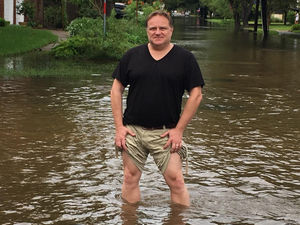
Richard Amos, who now lives in Houston, is housebound by floodwaters that have covered the city in the aftermath of Hurricane Harvey.
He has described the situation as a "complete disaster" and says it will take the city years to recover.
Mr Amos is associate professor of proton therapy at the University College in London, but lives in Houston, after moving there in 2008 to work at the University of Texas MD Anderson Cancer Center.
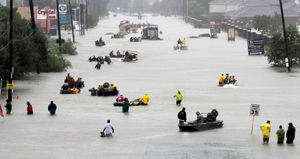
Originally from Newport, Mr Amos is now housebound in his home in central Houston with his wife Wendy and daughter Siona, five.
He is also separated from his two older children Alex, 11, and Lara, eight, who are with their step-father in a home about 20 miles away, also housebound by the water.
Their mother, a nurse, was called into the hospital where she works and has not been able to leave.
Mr Amos - whose parents, Sheila and Derek Amos live in Avenue Road, Newport, close to Burton Borough School - said he struggled to do justice to the situation, but described it as a "disaster".
He said: "We've been incredibly lucky, our house has not flooded, the water has been coming incredibly fast down our road and is up to knee-height on our drive but has not come into the house.
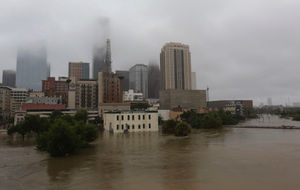
"We have friends, doctors and scientists, who have had to be rescued from the roofs of their home and have lost absolutely everything.
"I have friends, I know where they live and I have been to their houses, I can't get in contact with them but because I know where they are, on the edge of the rivers here in Houston, I know the houses will be gone."
He added: "Up to 10,000 US military personnel are coming to the area to aid with rescue and distributed of supplies.
"The flooding was so fast that hundreds of cars are submerged and people either escaped, or rescued from them. There are reports of some who drowned in cars."
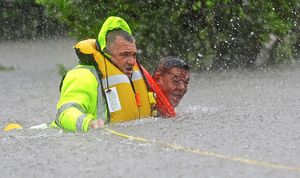
But he says the real story behind the floods is the way that the community in Texas has pulled together to rescue people.
Mr Amos said those with boats living in city had been carrying out private rescues of those whose homes had been totally covered in water. He also says people from Louisiana, who were affected by Hurricane Katrina back in 2005, have been driving for seven hours or more to offer their help to people living in Texas’ largest city.
He said: “The hospitals are closed except for emergencies, the airports are closed so getting in and out of the city is impossible. People have lost power, ours is intermittent.
“The mood here in Houston is people want to help as much as they can and are not relying on the government.
“Lots of people have boats here because we are not too far from the coast and they have been rescuing people from the second floors of their home, which is amazing.
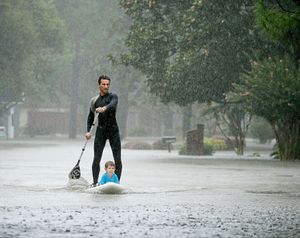
“Thousands and thousands of people have been rescued by private people.
“The emergency services are now advising people to stay in their homes but they are so overwhelmed they are asking those who do have boats to help.
“It seems my immediate neighbourhood is surrounded by neighbourhoods requiring boat rescue from homes.
“There are also people who were affected by Hurricane Katrina, which hit New Orleans, who have boats and are driving for seven hours to come down and help because they know what we are going through. It is amazing to see.”
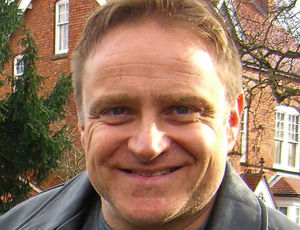
Mr Amos said the believed the shock of the situation would come later but at the moment people were just coming together to deal with what was happening on a daily basis. He said he had been “lucky” as his home has not flooded but added the water was right up to his doorstep, leaving him housebound.
But more problems are expected to come as levees that keep water from central Houston have already burst once and are in danger of bursting again.
Heavy rainfall that has fallen north of Houston will be coming through its Bayous, or small streams, and through the city adding more pressure to waterways.
Mr Amos aid the Army Corp of Engineers was bleeding water from the reservoirs to keep levels low.
But that in turn may cause some homes to flood while protecting even more, he explained. Yesterday, it was revealed a major dam outside Houston had begun overspilling as Storm Harvey pushed the reservoir past capacity. Engineers have tried to prevent nearby communities from being inundated by releasing some of the water held by the Addicks dam.
But flood control official Jeff Lindner says water levels are now over the height of the reservoir edge.
He said: “It is difficult stuff, there are still a lot of risks, it is not over yet.”
He also said animals like snakes and alligators were now entering the water from the south of Houston and popping up across the city In coming weeks, there may be issues as Houston will be hit with an influx of mosquitoes that are attracted to the stagnant water.
He said that being in a hurricane zone, the city was well prepared for what to do in such a situation but the sheer volume of water that had fallen on Houston had been impossible to manage. Mr Amos said: “What I will say is, the pictures are real, it really is as bad as it looks.
“Everything is real, it is an absolute disaster in Houston and it will take this city years to recover.”
Officials fear the death toll from flooding in Texas sparked by Hurricane Harvey could soar once the water recedes from one of America's most sprawling metropolitan centres.
Crews have been overwhelmed by thousands of rescue calls during one of the heaviest downpours in US history and have had little time to search for potential victims.
More than three days after the storm ravaged the Texas coastline as a Category 4 hurricane, authorities had confirmed only three deaths, including a woman killed when heavy rain dislodged a large tree on to her trailer home in the small town of Porter, but unconfirmed reports of others missing or presumed dead are growing.
The Houston metro area covers about 10,000 square miles and is criss-crossed by about 1,700 miles of channels, creeks and bayous that drain into the Gulf of Mexico, about 50 miles to the south east.
The storm is generating an amount of rain that would normally be seen only once in more than 1,000 years, said Edmond Russo, of the Army Corps of Engineers, which was concerned that floodwater would spill around a pair of 70-year-old reservoir dams that protect central Houston.
Rescuers are continuing to pluck people from inundated neighbourhoods, with mayor Sylvester Turner putting the number saved by police at more than 3,000.
The Coast Guard said it had rescued more than 3,000 by boat and air, and was taking more than 1,000 calls per hour.
A mandatory evacuation was ordered for the low-lying Houston suburb of Dickinson, home to 20,000 people
Harvey increased slightly in strength on Monday as it drifted back over the warm Gulf, according to the National Hurricane Centre.
Forecasters expect the system to stay over water with 45mph winds for 36 hours and then head back inland east of Houston some time on Wednesday. The system will then head north and lose its tropical strength.
Before then, up to 20in more rain could fall, National Weather Service director Louis Uccellini said. That means the flooding will get worse in the days ahead and the water will be slow to recede once Harvey finally moves on.




